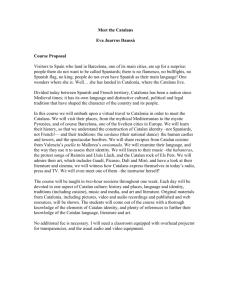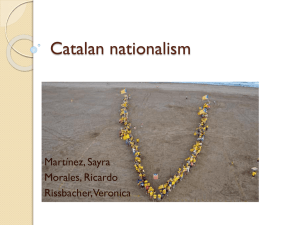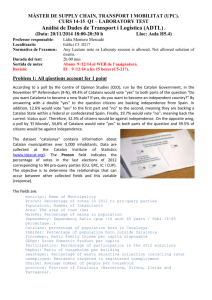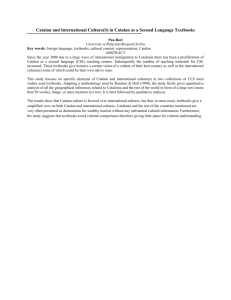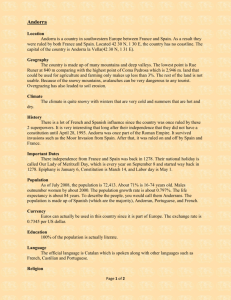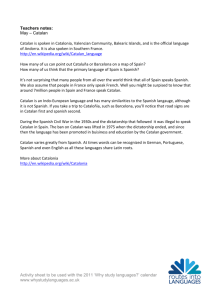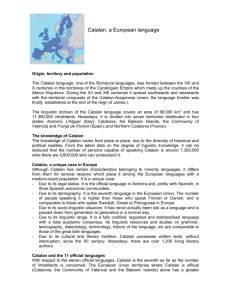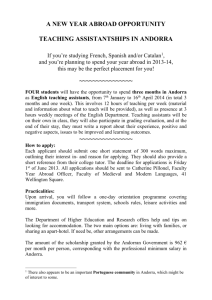cultural identity across the border - UEF-Wiki
advertisement
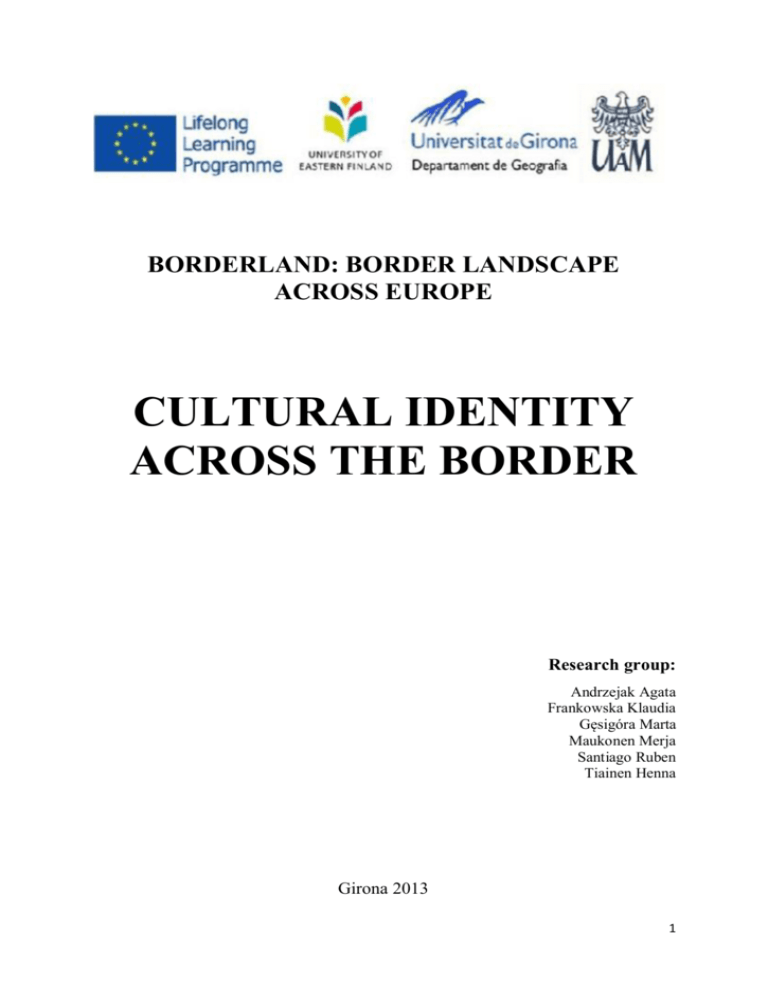
BORDERLAND: BORDER LANDSCAPE ACROSS EUROPE CULTURAL IDENTITY ACROSS THE BORDER Research group: Andrzejak Agata Frankowska Klaudia sigóra Marta Maukonen Merja Santiago Ruben Tiainen Henna Girona 2013 1 Content 1. Introduction 2. Theoretical background 3. Data and methods 4. Cultural identity 4.1. Catalonia 4.2. Andorra 4.3. France 5. Research area 5.1. La Jonquera 5.2. Le Perthus 6. Results 7. Conclusions 8. Bibliography 2 1. Introduction This report is a final form of project “Borderland: Border Landscape Across Europe” in which there were students from three European universities: Agata Andrzejak and Marta G sigóra from Adam Mickiewicz University in Poland, Klaudia Frankowska and Ruben Santiago from University of Girona from Catalonia and Merja Maukonen and Henna Tiainen from University of Eastern Finland. This project has been running since May 5th to May 18th 2013. The research areas were two towns: Catalan La Jonquera and French Le Perthus. The main aim of this research was to compare people’s cultural identity from both sites of the borderline and answer the question what cultural identity is and if it is exposed by inhabitants from La Jonquera and Le Perthus. La Jonquera is a Catalan town which has 2890 citizens and is situated in North Catalonia by the border with France, with the municipality of Le Perthus which is located in South France and has about 580 inhabitants. Both towns are divided by the borderline which marks cultural differences. In this report we will at first present some basic concepts and methods which we had used. Then we will present the theoretical aspects of cultural identity of Catalan, Andorran and French people. We will delineate politics, religions, languages, traditions and cuisine of each group. Then we will present the results of our research and the analysis of interview. In the conclusion we will show the major differences between people from Catalonia and France. 2. Theoretical background Cultural identity is a permanent identification of groups of people who share common territory, ideas, normative system and language which distinguish ethnic groups from one another and from the dominant culture. The dominant culture of the society refers to the main culture in a society which is shared, or at least accepted without opposition by the majority of people. 3 Formations of cultural identity pass through their own ‘deconstruction’ and permanent multiplication of cultural relations (Skulj 2000). Concepts of identity should not mean ‘to be something’ or to be identical with oneself. Cultural identity must not be defined only on a national ground. Ethnic groups dominated by main culture often try to keep their identity by expressing their culture, e.g. they speak their mother tongue and follow traditions. The problem of cultural identity involves the question of the self and of culture. In other words, this means reflection on the essence of culture itself and the implication that there is a reasonable motive of self-questioning (Skulj 2000). Concept of landscape is very difficult to explain. There are many definitions of landscape and it is perceived differently. Each person can describe this term otherwise because of cultural or personal reasons and also historical background. Each point of view is important and significant. As Antrop said, early landscape descriptions dealt with the geographical characteristic of foreign regions or countries. With the renaissance period in the 15 th century the first paintings and pictures of landscapes appeared in the Western World. There are more than once aspects of ‘land’. First of them is a natural aspect which is the most common usage of the term. The second aspect is economic and it is used to describe land as a property and the place where people can live. The third aspect is social and is used to describe the distinct area inhabited by a group of people, or a nation (Waage 2012). The European Landscape Convention defines landscape as ‘an area, as perceived by people, whose character is the result of the action and interaction of natural and/or human factors’ (Antrop 2005). Landscape refers to an organized and managed area. Border studies have become an interesting topic of research in the past few decades. The border studies are diverse including geographic and spatial scales. Borders can be considered for example as institutions and physical or cultural barriers. The border and boundary experiences are an important and interesting part of theory of bordering. The borders always include some while excluding the others. Borders also create differences between people living each side of the border, leading to the experiencing otherness and separate identities. Borders are not stable though, they can change through time. (Newman 2003.) 4 3. Data and methods To concretize our study we had to find statistic data to compare regions of Nothern Catalonia, Southern France and Andorra. Our sources were also brochures and leaflets which we got in many different places that we have visited. We also took some aerial photos which were used in this report. Then we made an interview in La Jonquera and Le Perthus and we asked people about their cultural identity. We asked for example if they express their identity and also we asked about their relations with people from the other side of the border. Then we analyzed the results and created some graphs. Very important sources were also articles and the lectures which gave us the basic knowledge about landscape and culture identity of Catalonia. 4. Cultural identity 4.1. Catalonia Catalonia is located in Northern Spain in Iberian Peninsula. It borders France and Andorra to the north, Spain to the south and the Mediterranean Sea to the east. Catalonia is divided into four provinces: Barcelona, Girona, Leeida and Tarragona. Barcelona biggest city is Catalonia which is also the capital of Catalonia. Catalonia has 7,565,603 inhabitants and covers an area of 32,107 km². Figure 1. Location of Catalonia 5 Figure 2: Geomorphology of Catalonia 6 Catalonia is a mountainous region with some lowlands at the coast. As it has been shown on Figure 2, in Northern Catalonia there are Pyrenees, marked in red color. Than on the south of Pyrenees are Pre-Pyrenees marked in brown. In yellow we have Catalan Central Depression, below Central Depression are located Catalan Pre-Coastal Range (in dark green) and Catalan Coastal Range(light green). Catalonia has its own representative and significant symbols such as the flag and emblem. The flag of Catalonia is called La Senyera. The flag has four The four stripes on yellow background. The four bars derived on the flag of Catalonia appears on a seal by Ramon Berenguer IV in 1150. It is an official symbol of Catalonia since 1932. Figure 3: Flag of Catalonia The emblem of Catalonia is called Coat of arms and consists of red bars as well as Catalan flag, but instead of five bars anthem has four bars on yellow background. This is one of the four oldest European shields which appeared first time in the year 1150. Figure 4: Emblem of Catalonia 7 Catalonia is an autonomous community and exercises its self-government in the Spanish State in accordance with the Constitution od 1978 and the new Statute of Autonomy, approved in 2006. The cultural identity of Catalonia is universal and strong based mainly on history. Traditionally, art and thought trends seep into Catalonia as a result of the country´s geographic location (close to the sea and Pyrenees and open to the European countries) . Catalonia has always been susceptible to the influence of neighboring countries. The official language of Catalonia is Catalan which was established between 8th and 10th Catalan is a mix of Spanish, French and Italian languages.. 98.8% citizens understand this language and it gives us in total over seven millions people who know this language. Catalan is also the official language in Andorra and it is used to the south of France too (especially in Perpignan). When we sum up the residents of Catalonia, Andorra and south of France we will receive nine million people that speak Catalan and about eleven million that understand it. In Catalan culture there are some important days. One of them is The National Day of Catalonia is a historic date in Catalan history. The holiday was first celebrated in September 11th 1886 when Barcelona was forced to surrender to the French and Castilian soldiers after a 13-month siege. Catalans wants don’t want to remember this defeat, they consider this day as the end of suffering. The second holiday is held on April 23rd and it is Saint George´s Day, also known as The Day of the Rose. It is the equivalente of well-known Valentine´s day. The main event is the exchange of gifts between loved ones and colleagues. It is a tradition that Men give women roses and women give men a book, it means ‘a rose for love and a book forever’. 8 There are a number of Catalan culinary traditions, some of them coincide with a religious festival, like cooking a big Christmas Day meal on December 25th which includes a soup esceduella i carn d’olla. Figure 5: Catalan meal esceduella i carn d’olla Another typical Catalan meal is bread with tomato rubbed over and seasoned with olive oil and salt, we can also add a bit of garlic which should be rubbed on the bread before rubbing tomato. It is called Pan amb tomàquet. Figure 6: Pan amb tomàquet. 9 4.2. Andorra Andorra (The principality of Andorra) is a microstate in the central Pyrenees, between Spain and France. The settlement is medieval origin. Andorra is as small as 468 km² and has 76 000 habitants of whom approximately 30 per cent are originally from Andorra. (Larrosa 2013.) Thus, it is the sixth smallest country in Europe. The capital of Andorra is Andorra la Vella. Andorra has two head of states: the Bishop of Urgell (Catalonia) and the President of France, although the Andorran people cannot vote in the presidential election. The existence of two princes can be seen as a tradition and a way of balancing between two big neighbours. (Allo´Expat Andorra 2013.) At the moment the co-princes are Joan Enric Vives Sicilia and François Hollande. Andorra has a parliamentary representative democracy with multi-party system and the Prime Minister, who at the moment is Antoni Marti. The Parliament, called the General council, consists of 28 councillors. (BBC 2012.) Figure 7: The Map of Andorra. (Istambuls 2011.) Andorra has collaboration with the European Union, however, it is not a member state. Since 2002 the currency has been euro instead of former Spanish peseta and French franc. (Allo´Expat Andorra 2013.) The economic situation has changed rapidly and thoroughly in 50 years from agriculture to tourism, commercial activity and financial activity. Andorra does not have primary production sector nowadays. (Larrosa 2013.) 10 The official language of Andorra is Catalan and other languages are Spanish, French and Portugal. There are a great deal of immigrants from Spain, France and Portugal. Andorra is a Catholic country with its traditions. (Allo´ Expat Andorra 2013.) Figure 8: The amount of visitors in Andorra. (Larrosa 2013.) The cultural features of Andorra are formed with the influence of Catalonia and France. Before 20th century the country was isolated from the rest of the world but lately tourism and immigration has had a major impact on Andorran culture. (Larrosa 2013.) Figure 9: The symbols of Andorra: the flag and the coat of arms. (Encyclopedia Britannica.) The culture of Andorra is also influenced by the Romans which can be seen in the Romanesque art. The Romanic art is the national art of Andorra. There are over 50 Romanesque churches in Andorra. Moreover, there is a rich folklore culture which originates from Andalusia and the Netherlands. (Allo´ Expat Andorra 2013.) Literature is important in Andorran culture. With a few famous writers, for instance Albert Salvado, Antoni Morell and Joan Peruga, Andorra has made an identifiable contribution to the Catalan culture. 11 The most popular festivals are The International Jazz Festival and The Ordino Classical Music Festival. Typical dances are the marratxa and the contrapàs. (Allo´ Expat Andorra 2013.) Andorran people have many festivals and national holidays which have their own traditional cuisine. Traditional food is for instance escudella, which is a stew of chicken, sausage and meatballs and roasted lamb. Andorran cuisine has influence from France and Spain. (Allo´ Expat Andorra 2013.) Moreover, the valley of Madriu-Perafita-Claror belongs to the Unesco World Heritage list. It is a cultural landscape of pastoralism, mountain culture and Pyrenees conditions. (UNESCO.) Figure 10: A Romanesque church. (Panoramio.) 4.3. France Catalonia shares border with France. France is a semi-presidential republic located in Western Europe. France is divided into 27 administrative regions, and Catalonia shares border with the regions named Midi-Pyrénées and Languedoc-Roussillon. Southernmost parts of France are the poorest areas of France whereas Catalonia is the richest area of Spain (Dr. David Gibant 14.5.2013). Wine and food are important parts of French culture. There is variation in the food culture between and within the regions of France. 12 France has strong democratic traditions. The President is Francois Hollande and the Prime Minister is Jean-Marc Ayrault. Argiculture has been and is an important sector in France, and the most typical imports are wheat, poultry, beef, pork and wines, of which champagne and Bordeaux wines are the most famous. (Bernstein 1991.) The freedom of religion is a constitutional right, and Church and State are kept separate from each other (concept of laïcité). Roman Catholicism has been the major religion in France, but in recent years the numbers of Catholics has decreased whilst the amount of agnostics and atheists has increased. (Bernstein 1991.) Historically France and Paris has been the center of high culture and decorative arts. The typical French culture or cultural identity is the result of internal forces such as educational system, mandatory military service, state linguistic, cultural policies and historic events. The French culture is heterogeneous and there is regional differencies in cuisine, dialect or accent, local traditions etc. (Bernstein 1991.) The basic and most important unit of French society has been the family, nowadays nuclear family, or different types of families (single parent, single, unmarried couples and civil unions. The educational system is centralized and organized into primary, secondary and higher education. Military service is compulsory to young men, which is thought to unify national identity. (Bernstein 1991.) Sports are an important part of French society, and football is the most popular sport. Besides football, rugby union, tennis, handball, basketball and sailing are popular. Local sport clubs get financial support from the local governments. (Bernstein 1991.) 4.3.1. Languedoc-Roussillon Languedoc-Roussillon, prefecture Montpellier, is the southernmost region of France. The region covers 27 364 km2 and there is 2 565 000 inhabitans. The president of the Regional Council of Languedoc-Roussillon is Christian Bourquin. Languedoc-Roussillon is made up of several historical provinces. The very southernmost part of Languedoc-Roussillon consists of five historical Catalan pays, which are Roussillon, Vallespir, Conflent, Capcir and Cerdagne. Pays is French word for an area, whose inhabitants share common geographical, econòmic, cultural or social interest (European Conference of Ministers of Transport 2004). 13 Catalan nationalists in Roussillon would like to Pyrénées-Orientales to secede from Languedoc-Roussillon and become an independent region, but the idea is not commonly popular. Some of the inhabitants would like to merge Languedoc-Roussillon and MidiPyrénées and thus reunify the old province of Languedo. (Generalitat de Catalunya 2004). Figure 11: Location of Languedoc-Roussillon Figure 12: The flag of of Languedoc-Roussillon French is the dominant language of the region. Before 20th century Occitan and Catalan were spoken in the region. Nowadays according to a research by Government of Catalonia, 65% of adults in Roussilon can understand Catalan, but only 37% can speak it. There have been attempts to revive both Occitan and Catalan in the region (Generalitat de Catalunya 2004). People of Languedoc-Roussillon appreciate good food and meals can take hours with several courses and chatting. A glass of wine is important part of the meal. The cuisine of Languedoc-Roussillon is diverse combination of the Mediterranean, the Catalan and the mountain cuisine. The cuisine of Languedoc-Roussillon has been influenced by the cuisines of Aragon and northern Italy, and also to some extent of Spain and Morocco. The main 14 ingredients are olive oil, tomates, garlic, onions and aromatic herbs. Sea food is important part of the cuisine. The specialities are oysters, gardiane (bull stew with rice), bourride (fish with aioli), morue catalane (cod with tomatoes and pepper), anchoiade (anchovies with garlic and olive oil) and creme catalane (cream with lemon, vanilla and fennel seed). Cheeses made in the region include pelardon, roquefort, bleu des causees and goat cheese (Terroir-France 2013). 4.3.2. Midi-Pyrénées Midi-Pyrénées, prefecture Toulouse, is the largest of the regions. The region covers 45 348 km2, and it doesn´t have historical or geographical unity. Historically Midi-Pyrénées consist of several former French provinces. French is dominant language of Midi-Pyrénées, and other languages used in the region are Occitan and Gascon, which are only spoken by older people in the distant areas of Quercy, Rouergue, the County of Foix, and Gasgony and the Pyrenees valleys, respectively. The French spoken in Midi-Pyrénées has an imprint from Occitan and Gasgony. (Maison de la France 2008) Figure 13: Location of Midi-Pyrénées region Figure 14: The flag of Midi-Pyrénées region Midi-Pyrénées cuisine is influenced by French, Spanish and Gasgony cuisines. Famous products are mountain French cheese, truffles and walnut oil. Also red Peppers, tomatoes and Bayonne ham are typical for the region. Well-known specialities are liver pâtés, goose or duck confits, respounjous, cassoulet etc and cheeses (Maison de la France 2008). 15 5. Research area 5.1. La Jonquera La Jonquera is a town located in Northern Catalonia in province Girona. It is situated in Spanish-French border and is a twin-town to French Le Perthus. There are 2890 people living in La Jonquera and its area is about 57 km2. 5.2. Le Perthus Le Perthus is a French town located in Southern France in Languedoc-Roussillon region. Its area is about 4.30 km2 and has about 580 citizens. Le Perthus is a border town, partly in Spain and partly in France, situated on the Route Nationale RN9. The frontier passes through part of the main street. The Spanish part is almost entirely devoted to the sale of alcohol, tobacco and other goods which are considerably cheaper than in France, resulting in the town being crowded with bargain hunters from France. 16 Figure 15 and 16: The borderline between La Jonquera and Le Perthus 6. Results Our research group made an interview about cultural identity of people living on both sides of Catalan-French border. The survey was made in La Jonquera and Le Perthus. We interviewed people of different age. We asked them about their relations with people from the other side of the border, reasons to visit both towns, conflicts between French and Catalan people and how they express their culture and if they use any cultural symbols. Speak French The relation with French people No relation Reasons to Visit Type of a conflict Using cultural symbols Shopping No No expression Catalan 40 A little bit years old No Catalan Flag and Catalan 25 A little Only Business No Visit bit Barcelona t-shirt years old No Only Business Shopping No Catalan Flag Catalan 30 years old No No relation No Visit No No expression Catalan 45 years old No Only Business No Visit No No expression Catalan 60 years old Friendly No Visit No Barcelona t-shirt Catalan 24 A little bit years old No relation No Visit No Catalan Flag Catalan 20 A little bit years old Table 1: Cultural identity research in La Jonquera and Le Perthus 17 As the table above shows, four of seven people can speak French but only a little bit. Three of them don’t speak the language and these are older people. That might mean that Catalans want to use mostly their mother tongue. But there are younger people from Catalonia who can speak French and it might be because they want to improve their future. Young people learn languages nowadays because it is an opportunity to travel abroad and live in other countries. Three of the people we interviewed said that they don’t have a relation with people from French side. Another three people said that they go to La Jonquera only in business relations and they tolerate each other but don’t get into closer relationships. Only one person, a 24year-old Catalan, told us that he has a good and friendly relation with French people. Catalan people visit very rarely French town Le Perthus. Five of interviewed people said they never visit the French side. Two of them told us they go to La Jonquera and Le Perthus only for shopping and to buy some cheap products. No one of interviewed people is in any conflict with French people. Their relations are neutral, and if Catalans visit the French side, they must speak French, but if people from France visit Catalonia, they don’t need to speak Catalan or Spanish. This was the only conflict we have heard about from Catalans. We also asked people if they express their cultural identity. The majority does express their identity by posting Catalan flags and wearing Barcelona T-shirts with Catalan symbols. Only few people told us that they don’t express their identity in any way. Below there are tables with answers of Catalans. Do Catalan people speak French? 18 Reasons to visit La Jonquera and Le Perthus. The relations between Catalan and French people. Using of cultural symbols. 19 Speak Catalan French 25 years old No The relation with Catalan people Cordial Reasons to Visit Type of a conflict Using cultural symbols French 65 years old No Only Business Shopping and Holidays Shopping No No expression No No expression French 25 years old No Only Business Shopping No Catalan Flag French 33 years old No Cordial No No expression French 60 years old A little bit Only Business No No expression French 30 years old Yes Friendly Shopping and Holidays Shopping and Holidays Shopping No No expression Table 2: Cultural identity research in La Jonquera and Le Perthus The second group of people we interviewed were French. We asked them if they speak Catalan and only one of them said that he can speak this language and the other one can speak Catalan a little bit. Rest of them do not know this language at all. One person was a policeman who is French Catalan and does speak only French and Spanish. People from France don’t identify with Catalan culture and don’t want to learn Catalan language, as one of asked person said. 50% of asked people said that they have only business relations with Catalans and they do not have negative attitude to each other from both sides of the border. The other 50% of people told us, they have good, friendly and cordial relations with citizens of Catalonia. The main reason of French people to visit La Jonquera was shopping. Low prices and diversity of products attract people from both, France and Catalonia, to these twin-towns. Citizens from France very often come to Le Perthus to buy some products because it is cheaper there than in many other towns in France. Besides, the diversity of products allows people to buy everything, from clothes and food, alcohol and cigarettes to furniture in one place. Half of asked people said they come to the border to do some shopping and also for holidays. 20 None of French people is in any conflict with Catalans. They said that Catalans are friendly, but sometimes it is hard to trust them when they do not know each other. Catalans from France do not feel cultural identity as much as citizens from Catalonia and they do not consider it as a problem. All of asked people told us, they do not express their identity by using French cultural symbols. Although there was one young woman who said she has a Catalan flag in her car. They do not feel that they need to express their identity. Do French people speak Catalan? Reasons to visit La Jonquera and Le Perthus. 21 Relations with Catalan people. Using cultural symbols. The survey has shown us that Catalan people express their cultural identity more than people living in France. They have flags and even wear clothes with cultural symbols of Catalonia. Both, Catalans and French people do not have any conflicts with each other. Inhabitants from twin-towns, Le Perthus and La Jonquera are friendly to each other and they tolerate the other culture. Mostly the cultural identity is shown by citizens of Catalonia. There are many cultural symbols, such as flags, on the streets and in many houses. We can find there a lot of souvenirs with Catalan symbols. 22 In Andorra there were also Catalan symbols, such as flags, but not as much as in Catalonia. It might be caused by many Catalans who live there. There is about 36% of Catalans living in Andorra. Even if they are citizens of Andorra, they do not forget their culture and they remind us who they are. There are Catalan people living in France but they do not express their identity. Some of them do not speak Catalan and even do not want to learn this language. They do not feel Catalans as much as people from Catalonia or Andorra and it might lead to the situation in which French Catalans will consider them only as French and will not consider them as Catalans. In Catalonia the culture identity is shown to people since they are children. They are raised up in Catalan culture, they learn everything about who they are to remember their identity. They have their own cuisine and Catalan holidays. The most important symbol of Catalonia is the Catalan language which they learn and use all the time to show other people that they are not Spanish. In Andorra the Catalan language is not so important although it is used by many people. But in France Catalans do not feel the need of learning their language. 7. Conclusion Cultural identity consists of several aspects. The most important aspects of cultural identity arise from ethnic, racial, linguistic, religious and national cultures. In late-modernity cultural identities are claimed to be in crisis because of globalization, immigration and mixing of the cultures. Modern societies and thus cultures are societies of constant and rapid change. Representation form and transform the cultural and national identities. (Hall 1996.) Cultural identities change gradually across the borders of states and the cultures of the states sharing a border share also cultural features. In the case of Catalonia, France and Andorra, the cultures have influenced each other in the past and nowadays. Citizens of Catalonia are very proud of being Catalans and it is very important to them to show their culture to other people. The Catalan identity is not so important for Catalans living in Andorra and in France. The most important symbol which distinguishes Catalans from other ethnic group is Catalan language. Even if there are Catalans on two sides of border, they do not behave the same but tolerate each other. The difference between Catalans from France 23 and Catalonia might be caused by the territory where they live. Catalans from Catalonia have their own territory in Spain where they can freely express their cultural identity and even try to be independent. Catalans living in France are in quite different situation, because their culture is dominated by French culture. Besides, there is no such big territory in France, where Catalans live, so Catalans from there consider themselves only as French. Very often the frontier is not a barrier for ethnic groups to show their identity. The expression of identity depends on group´s mentality. Considering twin-towns La Jonquera and Le Pertfus located on both sides of a border, there is a difference, because the borderline is very significant even for cultural aspects. 8. References Antrop, Marc (2006). From holistic landscape synthesis to transdisciplinary landscape management. In: Tress, B.; Tres, G.; Fry, G.; Opdam, P. (Eds.): From Landscape Research to Landscape Planning: Aspects of Integration, Education and Application, 27-50. Generalitat de Catalunya: Catalan flag http://www.gencat.cat/catalunya/cas/coneixer-simbolsnacionals.htm 15.5.2013. Símbolos de Catalunya y Heráldica: Catalan emblem http://www.scgenealogia.org/catalunya/heraldica.htm 16.5.2013. Generalitat de Catalunya:Catalan culture http://www.gencat.cat/catalunya/eng/coneixer-cultura.htm 15.5.2013. Generalitat de Catalunya: Catalan language http://www.gencat.cat/catalunya/eng/coneixer-llengua.htm 15.5.2013. National day Day of Catalonia in Spain http://www.timeanddate.com/holidays/spain/catalonia-day 15.5.2013. Sant Jordi -history of celebration/ http://santjordi.yaia.com/historia.html, 15.5.2013. Worlds of flavor Catalonia, Catalan cuisinehttp://www.worldsofflavorspain.com/node/750 15.5.2013. Allo`Expat Andorra (2013). Cuisine. / People, language, religion. / Government. / Economy www.andorra.alloexpat.com/andorra_information/cuisine_andorra.php. 15.5.2013. 24 About-France (2011).A guide to the Midi-Pyrenees. http://about-france.com/regions/midipyrenees.htm. 15.5.2013. BBC (2012). Andorra profile. http://www.bbc.co.uk/news/world-europe-17028056. 15.5.2013. Bernstein, R. (1991). Fragile Glory: A Portrait of France and the French. Plume. Encyclopedia Britannica (2013). Andorra flag. http://global.britannica.com/EBchecked/topic/1354623/Andorra-flag-of 16.5.2013. European Conference of Ministers of Transport (2004). Assessment & Decision Making for Sustainable Transport. OECD Publishing. French-Property.com (2013). Midi-Pyrénées Food and gastronomy. www.regions-offrance.com/regions/midi_pyrenees/food-gastronomy. 15.5.2013. Generalitat de Catalunya (2003). Enquesta dúsos linguistics a la Catalonia Nord. http://www20.gencat.cat/docs/Llengcat/Documents/Dades%20origen%20territori%20i%20po blacio/Altres/Arxius/catnord2004.pdf. 15.5.2013. Generalitat de Catalonya (2013). Agencia Catalana de Turisme. http://www.act.cat/ 15.5.2013. Generalitat de Catalonya (2013). ICC. http://www.icc.cat/ 15.5.2013. Hall, S., Held, D., Hubert, D. & Thompson, K. (editors) (1996). Modernity. An introduction to modern societies. Blackwell Publishers Inc, Oxford. Istambuls (2011). http://istambuls.files.wordpress.com/2011/04/andorra-map.png 15.5.2013. Larrosa, Ma. Jesùs Lluelles (2013). The modernization of Andorra-lecture. Maison de la France (2008). Midi-Pyrénées. http://us.franceguide.com/Discover-the-cuisineof-Midi-Pyrenees.html?NodeID=1&EditoID=181722 . 15.5.2013. Newman, D. (2003). On Borders and Power: A Theoretical Framework. Journal of Borderland Studies 18: 13 – 25. Panoramio. http://mw2.google.com/mw-panoramio/photos/medium/59843163.jpg 15.5.2013. Terroir-France (2013). French wine guide. http://www.terroirfrance.com/wine/lr_food.htm#.UZNUDoZ4lOI . 15.5.2013. 25 The official website of France (2013). http://www.france.fr/en/regions-and-cities/languedocrousillon-microcosm-france-south-france. 15.5.2013. UNESCO. Madriu-Perafita-Claror Valley. http://whc.unesco.org/en/list/1160. 15.5.2013. Waage, Edda R.H. (2012). Landscape in the sagas of Icelanders: The concepts of land and landsleg. Norsk Geografisk Tidsskrift – Norwegian Journal of Geography, 66:4, 177-192. 26

